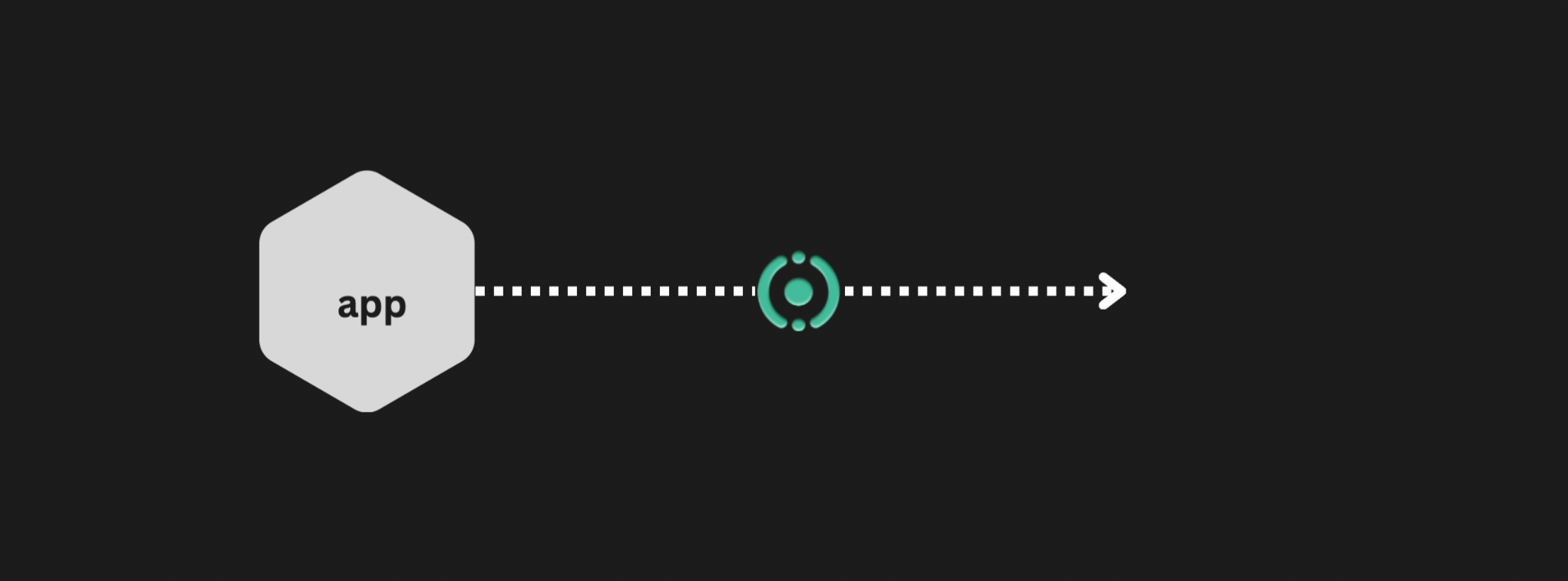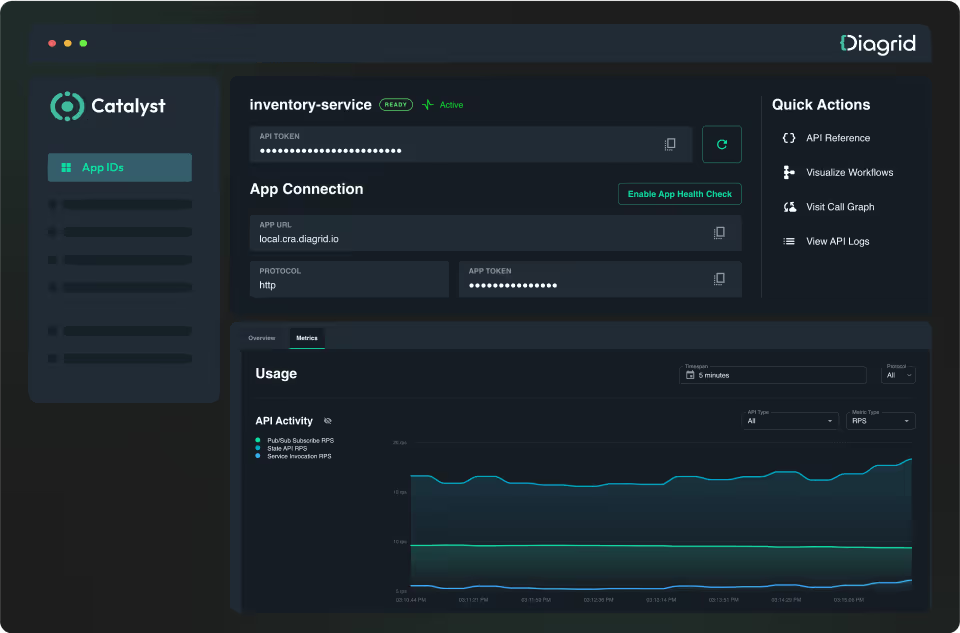Microservices
Build resilient microservices with service discovery, state management, and reliable messaging patterns using Catalyst, decoupled from the underlying infrastructure across on‑premises and cloud environments.

With Catalyst, you benefit from built-in best practices, security, reliability, and observability capabilities that give you clear visibility into service interactions, so you don't need to write boilerplate code to achieve production-ready microservices.
Resilient Orchestration
In microservices architectures, ensuring data consistency and coordinating long-running business processes across services is a challenge when each service owns its data. Catalyst’s workflow capabilities provide stateful, fault-tolerant orchestration that makes it easy to express multi-step business logic, handle retries, and maintain consistency across services.
One of the common ways to address this is the Saga pattern. It breaks a distributed operation into a sequence of local transactions, each executed within its own service and database. If any step fails, compensating actions revert previous changes to keep the system consistent.
Key capabilities:
- Workflow orchestration - Define complex business processes in code with guaranteed execution through durable, stateful workflows that survive failures and restarts.
- Saga pattern implementation - Orchestrate interactions across multiple services with reliable consistency and without relying on distributed transactions.
- Transactional Outbox pattern - Automatically propagate database changes to other services using asynchronous pub/sub.
- Compensation logic - Roll back or undo operations when workflows fail partway through to maintain consistency in distributed systems.
Catalyst's Workflow engine serves as a foundational tool for orchestrating microservices, streamlining complex process execution in a reliable way.
Reliable Communication
Synchronous request and reply remains one of the most common communication patterns in microservices, but doing it reliably in production is not trivial. Services must communicate securely, recover from transient failures, and provide full observability.
Catalyst’s Service Invocation API enables applications to communicate securely with built-in authentication, enforce fine-grained authorization policies, handle transient failures, and expose tracing and metrics data.
Key features:
- Service discovery - Automatically locate and route to target services in dynamic environments
- Built-in resiliency - Reliable service-to-service and service-to-infrastructure communication with retries, timeouts, and circuit breakers protect against transient failures and prevent cascading failures.
- Authentication and Authorization - Use mTLS to authenticate services, encrypt all data in transit and define which services can call others and which operations they can perform.
The Service Invocation API provides a simple way for microservices to communicate synchronously without requiring developers to manage reliability, security, or observability themselves.
State Management
Catalyst provides a key/value-based state API with pluggable state stores for persistence, enabling microservices to maintain state across requests and service restarts.

Rather than being limited to a single database, Catalyst's state management allows you to choose from 30+ different state store providers, from Redis and PostgreSQL to AWS DynamoDB and Azure Cosmos DB, enabling you to select the right persistence layer for your production requirements.
Key features:
- Transactional operations - Perform atomic multi-item transactions across state stores, ensuring data consistency
- State TTL - Set time-to-live values on state entries for automatic expiration and cleanup
- Encryption at rest - Protect sensitive data at rest with provider-agnostic encryption and key rotation capabilities designed for regulated environments.
- Multi-tenancy - Support multiple tenancy levels by allowing each application to define whether its state is isolated, shared with specific applications.
The State API decouples your application code from the underlying storage infrastructure, providing portability and addressing cross-cutting concerns.
Job Scheduling
Many microservices need scheduled work, for example running nightly database backups, executing daily ETL pipelines, sending periodic email reports, or settling financial transactions at the end of the business day. Catalyst's Jobs API provides an orchestrator for scheduling such jobs to run in the future at specific times or intervals, enabling you to build reliable, time-based background processing without manual intervention.
Key features:
- Job scheduling - Schedule one-off or recurring jobs to run at specific times or intervals with durable execution guarantees.
- Reliable execution - Jobs are durable and survive process restarts and infrastructure failures, ensuring scheduled tasks still run.
Infrastructure Decoupling
Catalyst's component model decouples your application code from the underlying infrastructure resources, enabling true portability and multi-cloud deployment. Your microservices can be deployed on your preferred infrastructure, whether on-premises or in any cloud environment.
When you use Catalyst APIs such as publish/subscribe, you can change your message broker by swapping a YAML configuration file, for example moving from RabbitMQ to Kafka or from Azure Service Bus to Google Pub/Sub. The same applies to state stores, where you can switch from Azure Cosmos DB to AWS DynamoDB by updating configuration only. In all cases, no changes are required to your application code.
Key benefits:
- Infrastructure portability - Switch between message brokers, databases, secret stores, and other components without modifying application code
- Multi-cloud deployment - Run the same application code across different cloud providers (AWS, Azure, GCP) or on-premises environments
- Bindings integration - Catalyst can connect to external cloud services through bindings without changing application logic.
Catalyst applications can run on Kubernetes, on any virtual or physical machine, or at the edge, and all of them use the same consistent Catalyst APIs and benefits.
Observability and Visualization
With Catalyst's built-in dashboards, and metrics, teams can monitor microservice interactions, identify bottlenecks, and quickly diagnose failures.

Catalyst visualizes microservice communication patterns, whether request-reply or message-driven. You can zoom into an individual service to see all of its communications and infrastructure dependencies, then dive into specific calls to diagnose failures and latency. You can also explore workflow traces and inspect the behavior of each workflow activity.
Key capabilities:
- Application graph - Visualize how services interact with each other and with their infrastructure dependencies, giving a clear map of synchronous calls and asynchronous messaging flows.
- Metrics dashboards - Monitor service health using networking golden metrics, latency, throughput, and error rates.
- API call inspection - Drill into individual API calls to analyze failures, latency, and end-to-end behavior.
- Workflow visualization - View workflow execution paths and inspect each activity to understand long-running or multi-step processes.
These capabilities allow operations teams to diagnose issues quickly and operate applications reliably in production.